Canon PowerShot SX20 IS
-
-
Written by Gordon Laing
Canon PowerShot SX20 IS design and controls
The Canon PowerShot SX20 IS shares essentially the same body as its predecessor, and like most super-zoom models is designed like a miniature DSLR with a defined viewfinder head, large grip and protruding lens barrel. The major benefit of a super-zoom over a DSLR is of course is the optical range with the SX20 IS housing the same considerable 20x zoom as its predecessor, compared to the typical 3x ranges of most DSLR kits. We’ve pictured it below alongside its major rival, Panasonic’s Lumix DMC FZ38 / FZ35, which sports a slightly shorter 18x range.
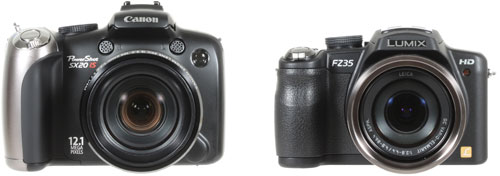 |
Measuring 124x88x87mm, the SX20 IS shares exactly the same dimensions as its predecessor. It’s also 6mm wider and 13mm taller than Panasonic’s FZ38 / FZ35, although 2mm thinner. While the photos above and below illustrate how the Canon super-zoom is noticeably larger than the Panasonic, they don’t reveal their surprising difference in weight. The FZ38 / FZ35 weighs 414g with its battery compared to the 680g of the SX20 IS when fitted with four typical AA batteries. Indeed the SX20 IS operational weight is only 20g lighter than Canon’s own EOS 1000D / XS DSLR complete with its battery and (admittedly 3x) kit lens.
It’s actually quite surprising how much heavier the SX20 IS feels in practice than the FZ38 / FZ35, with the Panasonic feeling relatively empty in comparison. Some may prefer the extra heft of the Canon and the confidence it instils, while others would see the relatively light weight of the FZ38 / FZ35 as a key advantage. We strongly recommend picking up both – with their batteries fitted – to see for yourself.
The Canon may be comfortably heavier, but the build quality of the two models is roughly the same. Both share similar plastic exteriors with good joins and no creaking or flexing to worry about, but Canon’s flagship PowerShot G11 ultimately feels slightly tougher.
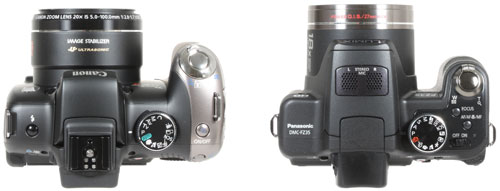 |
Viewed from above, the SX20 IS features a slightly larger grip than the FZ38 / FZ35 – indeed it’s roughly the same size as the company’s entry-level DSLRs. This along with a bulge on the rear for your thumb allows you to grip the SX20 IS very comfortably and securely, although it could have been that much classier coated with the mottled rubber finish of the FZ38 / FZ35 or EOS 450D / XSi’s grips.
The SX20 IS shares the same external controls as its predecessor, with the similarities extending to the same options on the main mode dial: Auto, PASM, a single Custom mode, Stitch-Assist, Movie, four popular scene presets, and a SCN position which access a further eight presets plus a 3200 ISO option and Canon’s colour swap and colour accent modes. Like its predecessor, the SX20 IS offers complete manual control over both the aperture and shutter, and we have full details in the next section below.
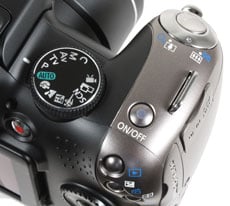 |
| ||||||||||
Unlike most digital cameras, you don’t need to switch to movie mode and press the shutter release to start filming. Like its predecessor (and now also the FZ38 / FZ35), the SX20 IS features a dedicated record button on the back for video. This allows the SX20 IS to start recording video at any time regardless of the mode you’re currently using. Conversely, when you’re recording video, you can press the shutter release at any time to take a still image – albeit temporarily interrupting the video. As before, this essentially renders the movie mode position on the Command dial redundant, but it does reinforce the camera’s superior video recording capabilities.
As before, a group of four buttons start on the upper right surface and follow the curve of the thumb rest round the rear: the biggest is the power button, followed by buttons for playback, exposure compensation and AF frame area.
The exposure compensation button doubles as an AE lock, but only if you’re half-pressing the shutter release at the same time. The controls are positioned so it’s easy to get your finger and thumb in the right places, but it takes a little practice to get the different pressures right and not accidentally take a photo as you push in the compensation button.
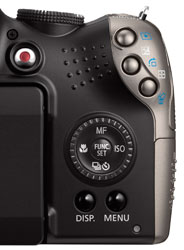 |
To the right of the screen you’ll find one of Canon’s thumb wheels with a cross-key arrangement in the middle. At first glance, the wheel appears similar to that on other Canon compacts, but there are size and tactile differences.
The wheel on the SX20 IS is stepless and completely smooth to turn, compared to the discreet steps felt on the wheels of the other models as you turn them. The SX20 IS’s wheel is also smaller than the PowerShot G’s version, and rather than having separate cross-key buttons in the middle, the entire disc is pushed up, down, left or right.
The reason we’re going into detail is there’s quite significant ergonomic differences in terms of use. We personally much preferred the physical feedback from models featuring wheels with discreet steps over the stepless motion of the SX20 IS. On the other models you can feel when you’ve made a change, whereas on the SX20 IS you have to watch the screen to see how much you should turn the wheel. We also prefer the internal cross keys to the entire wheel tilting. This is of course all personal preference, and we’d advise you try them for yourself to see which feels best to you. It just seemed a little odd that Canon would have at least three different disc controls for its compacts, in addition to the larger wheels on its EOS DSLRs.
The theory’s the same though. Depending on the mode at the time, a spin of the wheel could adjust the aperture, shutter, exposure compensation or manual focus distance, select a scene preset, or scroll through either menu options or images in playback. While we ultimately preferred the clicking feedback on the dials of other Canon models, the SX20 IS still offers quick and tactile control over various options, and it’s a lot easier to do this than prodding the tiny joystick on the Panasonic cameras.
Pushing up, down, left or right on the edge of the wheel will set the SX20 IS’s manual focus, drive mode, macro mode and ISO sensitivity respectively, while pressing the FUNC / SET button in the middle either confirms an action or fires-up the superimposed Function menu for quick access to various settings – see further details below.
Canon PowerShot SX20 IS exposure and metering
The Canon PowerShot SX20 IS offers shutter speeds from 1/3200 to 15 seconds, along with 10 apertures from f2.8 to f8 (when zoomed-out), and you have complete control over both settings in its Manual, Aperture or Shutter Priority modes. Exposure bracketing is also available, but fairly basic with three frames up to 2EV apart.
 |  |
Like many non-DSLRs, there’s some restrictions concerning the faster shutter speeds with certain apertures. With the lens zoomed-out, the fastest shutter speed of 1/3200 is only available at f8. Between f4 and f7.1, the fastest speed drops to 1/2500, while at f3.5 it’s 1/2000. Finally at the maximum aperture of f3.2-2.8, the fastest shutter speed becomes 1/1600.
The Panasonic FZ38 / FZ35 suffers from similar restrictions, only offering its maximum shutter speed of 1/2000 at the minimum aperture of f8. At the maximum f2.8 aperture, the FZ38 / FZ35 offers a fastest shutter speed of 1/1000. In its favour though, the FZ38 / FZ35 boasts a slowest shutter speed of 60 seconds to the Canon’s 15, which could swing it for fans of long exposures. Then again the FZ38 / FZ35 has a habit of selecting smaller apertures than it really needs to in Automatic modes, which in turn means it can suffer from diffraction (with a softening of detail) unless you intervene. Canon also makes better use of graphics to indicate the alterations which we’ll describe in more detail below.
 |
If you prefer an easier life for exposure, the SX20 IS has Program AE and Auto modes, along with 12 scene presets (four on the dial and eight in a menu) and Canon’s Colour Accent and Colour Swap; like other Canon compacts, the Colour modes allow you to select a colour and either change it to something different (such as turning a red London bus green) or make it the only colour in an otherwise black and white image (like the girl with the red balloon in Schindler’s List).
New to the SX20 IS over its predecessor is scene detection in Auto, and the implementation is an enhanced version of what we saw with the SX200 IS. As such, it doesn’t just recognise people or close-up shots, but also the lighting conditions for each, differentiating between bright conditions, blue skies or night-time, and whether the subject is backlit or (new to the SX20 IS) even if it is in motion. In each instance, the exposure and flash are adjusted accordingly, and the camera will even attempt to recognise a Sunset and boost the colours.
In practice, the system works well, seamlessly switching to portrait mode with face detection when faced with a person, or into macro mode when placed close to a subject. It’s also interesting to watch the change of icons in the corner of the screen as the camera detects different lighting conditions, although Canon admits pointing it at a blue or orange wall can fool the camera into thinking it’s either a glorious day or a spectacular sunset. That said, it’s a step-up in sophistication over the earlier SX10 IS and a welcome addition to the new model. To be fair though, Canon’s playing catch-up here as its rival from Panasonic has featured scene detection for some time, albeit not detecting as many lighting conditions.
Finally, the SX20 IS offers three main metering modes: Evaluative, Centre Weighted and Spot; the latter can be locked to either the central AE point or a selected AF frame in FlexiZone mode. We used Evaluative for all our test shots in Program mode and like other compacts in Canon’s 2009 range, found few occasions when we wanted or needed to intervene with compensation.
Canon PowerShot SX20 IS flash
|
 |
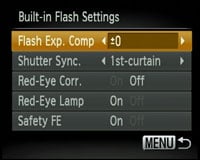 |
 |
The Canon PowerShot SX20 IS has a built-in flash that must be manually lifted open to operate. Once open, the flash can be set to Forced-on, Auto or Slow Synchro; if you don’t want it to fire, simply push it back down again.
A dedicated flash control menu offers flash compensation between +/-2EV and rear curtain options along with red-eye correction. If face detection AF is enabled, the face brightness is also evaluated before firing the flash.
Like its predecessor, one of the SX20 IS’s highlights is a fully-functional flash hotshoe which can be used to mount an external Speedlite 270EX, 430EX II or 580EX II. With any of these three models fitted, the flash control menu switches to external control, offering the same options as Canon’s latest DSLRs.
This allows you to again adjust flash compensation (albeit with a broader +/-3EV range), set rear curtain and slow sync options along with wireless control. The maximum sync speed with an external flash is 1/250.
Support for external flashguns, especially proper Speedlite units, is an impressive feature to have on the SX20 IS and elevates it beyond cheaper models – or indeed its arch rival, the Panasonic Lumix FZ38 / FZ35. It’s one of only three non-DSLRs in Canon’s current lineup to offer the facility – the other two being the flagship PowerShot G11 and the SX1 IS. The SX20 IS and SX1 IS also have an advantage over the G11 when it comes to using external flashes, as their larger grips make holding the camera with a Speedlite mounted much easier. Even large models like the top-end Speedlite 580EX II are relatively easy to accommodate.
Canon PowerShot SX20 IS Viewfinder
Like most super-zoom cameras, the Canon PowerShot SX20 IS is equipped with an electronic viewfinder (EVF) as an alternative means of composition to the main screen on the back. Like other EVFs, you’ll see exactly the same information and graphics as you would on the main screen, including framing guides, the live histogram, shooting details and even the menu pages, along with a 100% view of the image itself.
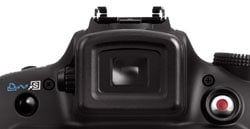 |
The EVFs on the SX20 IS and its arch rival the Panasonic FZ38 / FZ35 share a similar degree of detail (235k and 201.6k dot resolution respectively), but in use they look quite different. Canon’s used a 0.44in type, which looks much larger than the 0.2in type on the FZ38 / FZ35. Canon’s EVF fills your view, whereas the FZ38 / FZ35 comparatively looks like you’re peering down a tunnel.
Since both EVFs share the same detail though, Canon’s larger view suffers from a much coarser appearance. You can easily see the viewfinder pixels on the SX20 IS, whereas the FZ38 / FZ35’s forms a more cohesive image. Again it’s a case of swings and roundabouts though and which is better boils down to your own personal preference. The apparent size of the SX20 IS’s viewfinder is certainly impressive though.
A quick note on battery power – you may think using the EVF will extend your battery life, but Canon estimates a mere 3% more shots compared to exclusively using the screen. The EVF is however easier to use in direct sunlight and also more natural to use when framing at very long focal lengths.
Canon PowerShot SX20 IS Screen and menus
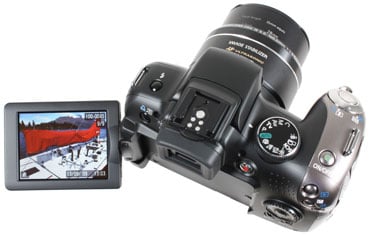 |
The Canon PowerShot SX20 IS is equipped with the same fully articulated 2.5in / 230k monitor as its predecessor. Like that model, this allows you to twist the monitor to almost angle, including facing the subject and back on itself for protection.
This is an undoubted highlight of the SX20 IS, giving you enormous creative flexibility when it comes to shooting at high or low angles, and the mounting itself feels very solid and secure.
It’s a key advantage over the Panasonic FZ38 / FZ35, which may have a slightly larger 2.7in screen, but one that’s fixed firmly in position.
The screen itself employs an updated panel over its predecessor, and it’s certainly more vibrant in use, although side-by-side, the one on the Panasonic looks a little crisper and enjoys greater impact. It’s a pretty minor difference though and most will prefer the articulation of the Canon screen.
Pressing the DISP button while shooting cycles between two viewing modes for the screen, followed by two for the EVF; when the screen is on, the EVF is off and vice versa. If the screen is folded back on itself, the DISP button sensibly only switches between the two EVF modes.
 |
 |
 |
Like its predecessor, you can use a Custom Display menu to choose what you’d like to see in each of the four modes. You start with a clean view of the image and can choose to add any combination of shooting details, an alignment grid, a live histogram and or 3:2 guides. It’s possible to customise these graphics on the screen and EVF separately.
Also inherited from the SX10 IS is a smart piece of graphic design where the current aperture or shutter are not just shown numerically, but additionally on a scrolling scale which reveals the settings on either side. For example in aperture priority mode, if you select f5.6, you’ll see f4.0 to the left and f8.0 on the right in the graphical scale, with marks for the third-stop increments between them.
 | 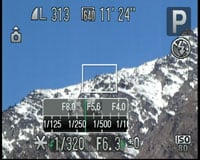 |
This is used to particularly good effect during auto-exposure AE lock, where scales are shown for both the aperture and shutter speed. As you turn the thumb wheel, the scales indicate what alternative shutter and aperture combinations could maintain the desired exposure.
So if you locked the exposure with the camera reading, say, f5.6 and 1/60, the scales would show you could alternatively head in one direction for f8 matched with 1/30, or go the other way for f4 matched with 1/120. In practice it’s a very quick and intuitive way to see what exposure options are available.
 | 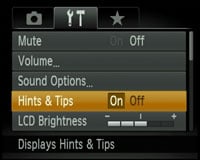 |
The PowerShot SX20 IS has also inherited the useful Function menu system of other Canon compacts, providing quick and easy access to common settings – although it’s been redesigned here with a different colour scheme.
Pressing the FUNC SET button overlays a list of options running vertically down the left side of the screen which you can select using the up and down buttons. The currently selected item reveals its available settings in a horizontal line at the bottom of the screen and you can use the left and right buttons or the thumb wheel to adjust them. As you select different options, you’ll also notice another new feature of the SX20 IS: hints and tips which explain what each setting does. These disappear after a few seconds, or can be disabled in the menus if preferred.
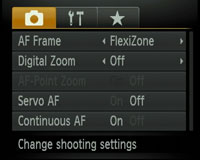 |
In P, A, S or M Modes for example, the options running vertically consist of White Balance, ‘My Colours’ options, Bracketing (for both exposure and focus), Flash Compensation, Metering, Drive mode, Movie quality and still photo resolution. It’s a really quick and easy way to make adjustments to these settings.
Pressing the MENU button presents three tabs for recording options, setup, and the configurable My Menu. This is down from the four tabs of the SX10 IS, but most of the same options are present, just rearranged a little.
During Playback, pressing the DISP button cycles between a clean full view, a full view with basic file information, a thumbnail view accompanied by a brightness histogram and full exposure details, and finally a focus confirmation option which shows two thumbnails, one of the entire frame, and a second showing the active focus area enlarged.
 |
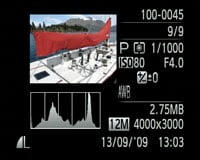 |
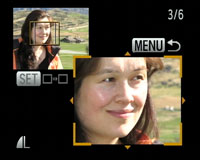 |
This last option comes into its own when you’re viewing photos taken with face detection as it allows you to quickly cycle-through close-ups of people’s faces to check for focus, red eyes or blinking.
Pressing the SX20 IS’s Menu while in playback presents a number of options for adjusting images including a red-eye correction mode. This uses face detection to frame the eyes of the subjects on your photos. You can then choose which frames to apply correction to and also whether you’d like the result to overwrite the original or create a new file.
The SX20 IS also uses its orientation sensor to flip images by 90 degrees during playback if you physically turn the camera. This can be handy for viewing portrait aspect images full-screen. The thumb wheel on the back of the camera can also be used to quickly scroll through thumbnails, although again the smooth stepless motion while turning it provides less tactile feedback than some other models in the range.
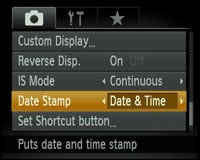 |
With so much in common with its predecessor, it’s a bit of a shock – not to mention a disappointment – not to find the sound recorder in the Playback menus. This was an often over-looked, but useful feature on the earlier SX10 IS which allowed you to record up to two hours of high quality audio – very handy for conducting an interview for example. Admittedly it may only be journalists who miss it, but it remains a sad and slightly curious omission.
Making up for it for some owners though will be the new Date Stamp feature. Like some other recent Canon compacts, this permanently writes the date and or time in the corner of the image. Such digital mutilation may horrify many photographers, especially considering the date and time are always present in the EXIF data of the file itself, but we’ve heard from sufficient numbers of people who want the feature to know it’s something of value.
|
Canon PowerShot SX20 IS Battery and connectivity
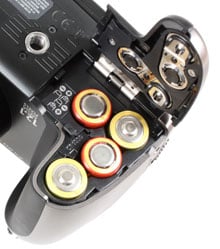 |
Like its predecessor, the PowerShot SX20 IS is powered by four AA batteries. Canon supplies a set of four disposable Alkalines to get you started, but you’ll want to invest in a decent set of rechargeables if you don’t already own any.
AA batteries of course have pros and cons. On the upside, they’re readily available pretty much anywhere, which is handy if you find yourself out of power in a remote location. On the downside, they’re bigger and heavier than most Lithium Ion packs, and in most cases, you’ll also have to supply your own rechargeables and a charger.
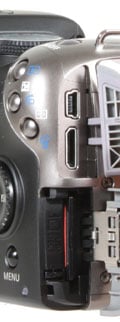 |
Under CIPA conditions, Canon estimates you’ll get up to 340 shots with the supplied Alkalines or 600 with a set of decent 2500mAh NiMH rechargeables when using the screen; switching to the EVF sees these figures increase to 350 and 620 images respectively. In contrast, Panasonic’s Lumix DMC-FZ38 / FZ35 has a much lighter rechargeable Lithium Ion battery pack, good for 470 shots under CIPA conditions.
As before, the SX20 IS’s batteries are housed in a compartment underneath the camera and like most models which use AAs, the door which holds them in place requires a little pressure to close it.
Again like its predecessor we’re pleased to find the memory card slot remains on the right side of the body, allowing you to change cards while the camera’s mounted on a tripod – something you annoyingly can’t do with the Panasonic FZ38 / FZ35.
Two flaps on the right side of the body protect the camera’s ports. As before, the upper door is home to the DC input and AV output, but the second door now houses a mini HDMI port alongisde the USB port of its predecessor. The presence of an HDMI port is one of the key upgrades over the earlier SX10 IS, although you should note Panasonic’s FZ38 / FZ35 now also features one.
Now let’s take a deeper look at the SX20 IS’s Features, including the lens coverage, stabilisation, autofocus options and its new movie mode.








